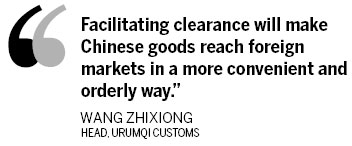Economy
Customs to make life easier for businesses in Xinjiang
By Yan Jie and Mao Weihua (China Daily)
Updated: 2010-10-21 14:01
 |
Large Medium Small |

URUMQI - Urumqi Customs is striving to make clearance procedures more efficient to help build Northwest China's Xinjiang Uygur autonomous region into a corridor for China's foreign trade with Central and South Asian countries, its head said in an interview with China Daily.
"Facilitating clearance will make Chinese goods reach foreign markets in a more convenient and orderly way," said Wang Zhixiong. "It will also reduce trade costs and speed up the transit of goods."
In Xinjiang, Urumqi Customs regulates 17 first-tier ports and 12 second-tier ports, the most in China.
Since 2006, it has established contacts with 19 of its counterparts in cities such as Tianjin, Xi'an and Beijing to simplify clearance procedures for exported or imported goods passing through areas under their administration, said Wang.
Since then, a great deal of time has been saved on customs clearance, he added.
More efficient clearance procedures have also been devised to facilitate bulk imports of resources that account for the majority of the goods imported through ports in Xinjiang.
|
||||
In addition, the customs launched a risk-based clearance procedure on July 15. In terms of factors such as categories of goods, prices, trading permits and partners, low-risk goods will be cleared automatically by computer, which means that clearance will be more efficient.
In six measures unveiled in 2008 to boost Xinjiang's economy, the customs promised to contribute to the construction of special regulatory zones such as the China Kazakhstan Khorgos International Center of Boundary Cooperation, which is located across a section of the border between China and Kazakhstan near the city of Khorgos in China.
Urumqi Customs has also helped Xinjiang with research on opening more ports in areas bordering Tajikistan, Russia, Kazakhstan and Kyrgyzstan.
Xinjiang's foreign trade rose 15.3 percent to $11.3 billion in the three quarters ending Sept 30 from a year ago, according to official figures.
The tariff income of the customs reached a record high during the same period, up 62.7 percent to $8.61 billion, surpassing the overall amount in 2009.




